Collages, Both Modern and Comical
Upon reaching her eighties, the artist whose work was once defined by such precise and detailed line work, found that she was losing the hand control that had been so central to her craft. So, being the pragmatist that she was, Alison Mason Kingsbury turned to collage and cut paper. With the new medium came a new looseness, irreverence, and more explicit sense of humor. Though her first collage and cut paper work dates from 1966, she moved to the medium exclusively by 1982. The incredible breadth of styles and subjects explored in these works is remarkable: from minimal doorways reduced to near abstraction to overwhelmingly cluttered collages marked by classical allusions. The extensive experimentation can be attributed in part to a response to her materials, ranging from the "extravagant" high quality papers that she would sometimes purchase to create her minimalist cut-paper abstractions to the bombardment of free catalogues that provided the fodder for her busy collages. However, one can also look to the license that the "retired" artist felt in her senior years to explore such wildly different avenues of expression.
In the final years of her life, A. M. K. continued to produce cut-paper and collage pieces. Her last known works, Time Piece and Paradise Lost from 1987, allude to a growing preoccupation with mortality. Paradise Lost is one of the artist's cluttered collages, which overflows with the bounty of a garden but is tended to by a mopey, grayscale Adam and Eve, who awkwardly wield their tools and bashfully wear their clothes in the aftermath of the Fall. Time Piece is a more economical work featuring ornate winged-clocks taking flight with their gears strewn about like innards.
Even the artist's dreams turned toward questions of life, death, and time. A. M. K. recounted one such dream to her granddaughter Susan. The artist found herself in a small boat on a peaceful lake with two classically beautiful young men, who dove off the vessel into the water and returned only to dive off again. Eventually, A. M. K. asked the men: "What is the meaning of life? Why do people continue living?" One of the men responded: "They want to see what will happen next." After considering the answer, A. M. K. came to the conclusion that she did not really need to know what happened next-she was ready to go. Shortly thereafter, the artist died in her home on Court Street at the age of ninety.
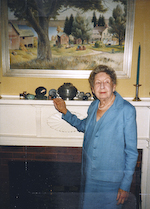 |
Alison Mason Kingsbury pictured in her Court Street Home. [1980 ca.] [zoom] Alison Mason Kingsbury poised in front of her 1940 painting Document in her recently purchased Court Street home. From the collection of Alison and Ricard Jolly |
 |
Alison Mason Kingsbury. Triumph of Good Riddance. [1980] [zoom] One of Alison Mason Kingsbury's "busier" collages made with magazine cut-outs. From a private collection |
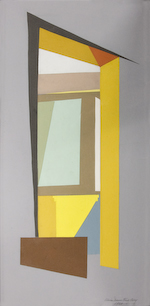 |
Alison Mason Kingsbury. Doorway No. 1. [1984] [zoom] One of Alison Mason Kingsbury's abstract collages made with cut paper. From the collection of Alison and Richard Jolly |
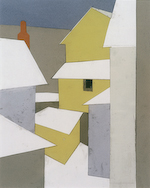 |
Alison Mason Kingsbury. Snow No. 2. [1986] [zoom] A cut paper abstraction of Ithaca's notorious winters. From the collection of Alison and Richard Jolly |
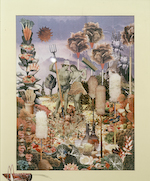 |
Alison Mason Kingsbury. Paradise Lost. [1987] [zoom] A modern collage commentary on Adam and Eve's Fall. From the collection of Alison and Richard Jolly |
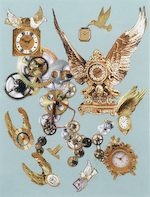 |
Alison Mason Kingsbury. Time Piece No. 2. [1987] [zoom] One of A. M. K.'s simplest magazine collages. A mediation on time that perhaps reflects a growing concern about mortality. From the collection of Alison and Richard Jolly |